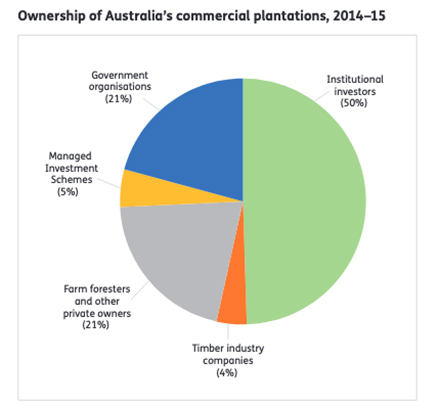
The Australian Bureau of Agricultural and Resource Economics and Sciences (ABARES) has released Australia State of the Forests Report 2018 (SOFR 2018). Acting ABARES Executive Director, Peter Gooday, said the five-yearly report covered all areas of Australia’s forests—public and private forests, forests managed for production and forests managed for conservation—and the full range of social, economic and environmental values. Source: Timberbiz
Key Facts:
Forest area
- Australia has approximately 3% of the world’s forests, covering 17% of Australia’s land area, and the seventh largest national forest area globally.
- Australia’s forests can be divided into three categories: Native forest (132 million hectares); Commercial plantations (1.95 million hectares); and Other forest, which is mostly non-commercial plantations and planted forests of various types (0.47 million hectares).
- The area of commercial plantation was 1.95 million hectares in 2014–15. This area increased from 1990 to 2010, but reduced by 44 thousand hectares (2%) between 2010–11 and 2014–15. The area proportion of commercial plantations where the trees are privately owned increased to 79% in 2014–15.
Economics
- In 2015–16, the value of logs harvested from native forests and commercial plantations was $2.3 billion.
- In 2015–16, the value of production of wood products industries (total industry turnover, or sales and service income) was $23.7 billion.
- In 2015–16, the value added by the forest and wood products industries (sales and service income minus costs) was $8.6 billion, representing a contribution to Australia’s gross domestic product of 0.52%.
Social and community
- In 2016, 11.0 million hectares of forest was on non‑Indigenous heritage-listed sites. In addition, in 2016 there were an estimated 126 thousand registered Indigenous heritage sites within forest.
- In 2016, the forest and wood products industries directly employed 1,099 Indigenous people, while an estimated 337 Indigenous people were employed in conservation or park operation roles in areas with forested conservation reserves.
- An annual average of 4.2 million visitors visited major forested tourism regions for bushwalking in the period 2011–12 to 2015–16.
Biodiversity
- A total of 46 million hectares (35%) of Australia’s native forest is on land protected for biodiversity conservation, or where biodiversity conservation is a specified management intent.
- Australia’s national lists of forest-dwelling species (species that use forests for part of their lifecycle) include 2486 forest-dwelling native vertebrate fauna species (animals), and 16,836 forest-dwelling native vascular flora species (plants).
- A total of 1420 forest-dwelling fauna and flora species are listed as threatened species under the Commonwealth Environment Protection and Biodiversity Conservation Act 1999.
- The most common threats to nationally listed forest-dwelling fauna and flora include forest loss from clearing for agriculture, grazing, and urban and industrial development; impacts of predators; small population sizes; and unsuitable fire regimes.
Forest Condition
- Australia’s native forests comprise stands at regeneration, regrowth, mature and senescent growth stages, as well as stands of uneven-aged forest.
- The total area of forest in Australia burnt one or more times during the period 2011–12 to 2015–16 was 55 million hectares (41% of Australia’s total forest area). Of the cumulative area of fire in forests during this period, 69% was unplanned fire.
- A total of 27% of Australia’s forests are managed primarily for protective functions, including protection of soil and water values.
- Carbon stocks in Australia’s forests increased by 0.6%, to 21,949 million tonnes, during the period 2011–16.
- In addition, in 2015-16, 94 million tonnes of carbon was present in wood and wood products in use in 2016, and 50 million tonnes of carbon in wood and wood products in landfill.
Employment and Education
- Two different surveys show that expenditure on research and development in forestry and forest products has declined over time, as has associated capacity. The number of people involved in research and development in forestry and forest products has also continue to decline.
- Total national direct employment in the forest sector was 51,983 persons in 2016, a 24% decrease from 2011.
- A total of 30 Local Government Areas are rated as dependent on forest and wood products industries through having 2% or more of their working population employed in the sector and containing more than 20 workers employed in these industries.
- Levels of community adaptive capacity varied considerably across the 30 Local Government Areas rated as dependent on forest and wood products industries.
- Nationally, 54% of forestry workers had non-school qualifications in 2016, compared with 65% in the total workforce.
Read the full Australia’s State of the Forests Report 2018 report to fully appreciate the scope of this national resource here:www.agriculture.gov.au/abares/forestsaustralia/sofr/sofr-2018







